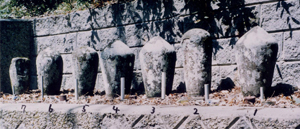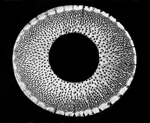|
To Be - or Not to Be: a "Zen Buddhist Priest"?
Web page revisited and checked on March 16, 2024.
虚無僧
と
禅宗? - KOMUSŌ and the ZEN SECT?
To be - or not to be: a "Zen Buddhist Priest"?
Were the 'komusō' ever real "Zen monks"?
Was the "Fuke Sect" ever anything like a "Zen Buddhist sect"?
This webpage was last updated on September 10, 2021.
Do note, by the way, that some webpage URLs/internet addresses may be changed over time.
禅
と
尺八 - 関係
が
全然無い!
"As for 'Zen' and 'Shakuhachi' - there is absolutely no connection!"
In early 1977, I was introduced to a most prominent professor at Kyōto University, namely the late Yoshida Mitsukuni, 1921-1991.
I had just been enrolled as a "foreign special research student" at the university, you see.
Having explained to Yoshida Sensei that I was very interested in studying the possible (at least so claimed)
relationship "between Zen and the bamboo flute shakuhachi", the professor promptly replied,
"There is no connection whatsoever!"
In very straight and direct Japanese: Zen to shakuhachi: Kankei ga zenzen nai!
Much surprised, as I was - honestly, I recall to have answered something like,
"Oh, I had better then look a lot more into that question!"
Which is, in fact, certainly and very much "exactly" what I have been doing ever since then.
Clarifying Statements
Acc. to Wikipedia, Japan - revisited on September 6th, 2021:
虚無僧は「僧」と称していながら剃髪しない半僧半俗の存在である。
"While 'komusō' called themselves "monks" [sō], they did not shave their heads and lived a life as half monks,
half lay persons [han-zō han-zoku]."
Trsl. by Torsten Olafsson
Link: Wikipedia, Japan:
虚無僧
Acc. to Wikipedia, Japan - quoting from a previous version of the webpage:
虚無僧(こむそう)とは禅宗の一派である普化宗の僧であり、剃髪しない半僧半俗の存在である。
"The socalled 'komusō' were monks of the Fuke Sect, a branch of the Zen Sect;
they lived a life as half monks, half lay persons [han-zō han-zoku] who did not shave their heads [teihatsu shinai]."
Trsl. by Torsten Olafsson
Acc. to Yamato Hōmei, 山戸朋盟:
つまり、虚無僧寺が禅寺で、虚無僧が禅僧だというのでは都合が悪い。
やはり、明暗寺は普化寺で、虚無僧は普化僧であるとしなければ世間に説明できないようなことが沢山あったのです。
早い話が、虚無僧は頭を丸めていません。
また、表向き帯刀はしていないにしても、懐剣や尺八などで武装しています。
その上、普通の禅僧のように朝早くから起きて読経・座禅・禅問答などの修行はしません。
また、普化寺には檀家もなく、だから檀家のための法事もしない。
さらに、仏法を真面目に勉強しているようには見えないし、現に、民衆に説法、つまり布教活動もしない。
それどころか、普化寺の中では、平気で酒を飲んだり博打をしたりしている。
極端な例では、寺の土地や什物を質に入れたりする者さえもいる。
これは虚無僧の立場からすれば当然のことでしょう。
なぜなら彼等は、僧という身分は「一時の隠れ家」で、自分たちは本来は「勇士」だと自覚しているのですから。
" - - -
Summing up, to say that "'komusō' temples were Zen temples" and that "'komusō' were Zen monks" is inconvenient [lit.: "circumstances are bad"].
Likewise, if one should not [say] that Myōan-ji was a "Fuke temple", and that the 'komusō' were "Fuke monks",
there would be a lot which could not be explained to the public.
To cut a long story short, the 'komusō' did not shave their heads [i.e. take the tonsure; become monks].
Also, although they did not wear a sword in public, they were "armed" with a dagger or a shakuhachi.
In addition, they did not engage themselves in the ascetic practices of an ordinary Zen monk, such as rising early in the morning and chanting sutras,
doing seated meditation [zazen], performing Zen question-and answers sessions [Zen mondō; Kōan] and the like.
Furthermore, neither did the "Fuke temples" have any patron households [danka], nor did they perform Buddhist funeral services.
Moreover, they do not appear to have been doing any earnest studies - in fact, they did not even preach to the masses,
nor did they, basically, live any life of propagating the faith.
On the contrary, within the "Fuke temple" precincts, they both drank alcohol unscrupulously and engaged in gambling.
As an extreme example, there were some ['komusō'] who even pledged the temple's land or treasures, furniture and utensils.
From the standpoint of the 'komusō', that might perhaps be expected?
The reason was, as for them, that their social status as monks was [but a] "temporary refuge",
and that they were proudly conscious of themselves as being essentially "brave warriors"."
- - - "
Trsl. by Torsten Olafsson
Link, webpage last visited on September 9, 2021:
Hōmei's Homepage:
朋盟のホームページ
Acc. to the official homepage of Izu City, Shizuoka Prefecture:
瀧源寺虚無僧の墓碑

普化宗は、髪を剃らずに袈裟を掛け、天蓋(編笠)に顔を隠し、
尺八を吹奏しながら諸国を行脚する虚無僧の宗派で、臨済宗の一派といわれます。
修験宗などとともに普化宗では葬式をしないため、
瀧源寺(ろうげんじ)の僧侶は金龍院の檀家となり、
金龍院の僧が葬式をしていたようです。
ただし、墓のある場所から、埋葬は瀧源寺の境内にされたことがわかります。
平成10年3月25日指定 伊豆市大平1456-1。
"'Komusō' gravestones at Rōgen-ji
[The members of] the Fuke Sect, while not having their heads shaved, wore a sacred shoulder scarf [kesa] (over their shoulders)
and concealed their faces under braided basket hats [tengai/amigasa].
The sect of the 'komusō' who blew the shakuhachi while travelling (as ascetics) all over the country,
are said to have been a branch sect of the Rinzai Sect.
Together with the Shugendō (of the 'yamabushi') and the like, as the Fuke Sect did not perform funeral ceremonies,
the ('komusō') monks of Rōgen-ji were patrons [danka] of the Kinryū-in (temple),
and it seems that the Buddhist priests of Kinryū-in performed their funeral rites.
However, judging from the location of the graves, we understand that these were placed inside the precincts of the Rōgen-ji (itself).
Designated on March 25, 1998, 1456-1 Odaira, Izu City."
Trsl. by Torsten Olafsson
New link visited on September 9, 2021 (scroll down a little):
Izu City Official Web Site: Historic Sites - Scenic Spots
More links c/o Google regarding "Komusō graves at Rōgen-ji"
Former, original link: Izu City Official Website
&
モリリン日記 weblog
Acc. to Nakatsuka Chikuzen (1979, p. 97),
Rōgen-ji was a subtemple of Anraku-ji, the
head temple of which was Reihō-ji near Edo.
Rōgen-ji was located in the vicinity of Izu City
on the Izu Peninsula, southwest of Tokyo.
Acc. to Makihara Ichirō's weblog, 牧原一路:
尺八と一休語りの虚無僧一路
'Shakuhachi to Ikkyū katari no komusō Ichirō':
"The Komusō Ichirō Talking about Shakuhachi and Ikkyū", August 10, 2007:
常識の嘘 普化宗など存在しなかった。
禅宗には、臨済宗と曹洞宗、黄檗宗、そして普化宗の4 つがあり、
虚無僧は普化宗の僧侶です」と中学の教科書にまで書いてある。
インターネットで関連サイトを見ても、すべてこう書いてある。
「虚無僧は、中国の普化(フケ)という禅僧を祖とする普化宗で、
日本には、鎌倉時代、紀州由良興国寺の法灯国師心地覚心が
伝えた」と。
みな間違い、大嘘だ。
- - -
虚無僧は、剃髪もせず、得度受戒もせず、僧籍も無いのだから、
僧ではない。
「僧であって僧でない」。
まるで禅問答である。
"A Common Sense Lie: Nothing like a 'Fuke-shū' ever existed."
"It is written in Japanese junior high school textbooks that (quotation)
"Within the Zen sect, there are 4 sects, namely the Rinzai Sect and the Sōtō Sect, the Ōbaku Sect, as well as the Fuke Sect;
the komusō are Buddhist priests [sōryo] of the Fuke Sect."
Also, when looking at related internet sites, it generally reads as follows:
"As for the 'komusō', the founder of the Fuke Sect was the Chinese Zen monk Fuke;
the tradition was transmitted to Japan by Hottō Kokushi Shinchi Kakushin of the Kōkoku Temple
in Yura in the Ki Province [present Wakayama Prefecture]."
This is all wrong, a big lie [taisō/ō-uso].
- - -
Because the 'komusō' neither shaved their heads [teihatsu mo sezu], were not initiated into Buddhist monastic life
receiving the precepts [tokudo jukai mo sezu],
nor were members of the Buddhist priesthood [sōseki mo nai], they were not Buddhist priests.
"Being a priest, or not a priest."
That is, in everything, a Zen paradox [Zen mondō]."
Trsl. by Torsten Olafsson
Link last visited on September 9, 2021:
尺八と一休語りの虚無僧一路
OBS: Published the same date, read also Makihara-san's article of August 10, 2007, titled
普化宗の日本開祖法灯国師も尺八を吹けなかった
'Fuke-shū no Nihon kaiso Hottō Kokushi mo shakuhachi o fukenakatta'
"The Fuke-shū sect founder, Hottō Kokushi, also couldn't play the shakuhachi."
Acc. to Makihara Ichirō's weblog, 牧原一路,
尺八と一休語りの虚無僧一路
, August 10, 2007:
虚無僧寺は元々浪人の溜り場である。葬儀を執り行うこともせず、墓地もない。
"Originally, the 'komusō' temples were places for masterless samurai to gather [rōnin no tomariba].
They neither conducted funerary services, nor did they have cemeteries [bochi mo nai]."
Trsl. by Torsten Olafsson
Link:
尺八と一休語りの虚無僧一路
Acc. to the weblog of Makihara Ichirō, 牧原一路,
平成の虚無僧一路の日記
'Makihara Ichirō: Heisei no Komus;0333; Ichirō no Nikki'
"Makihara Ichirō: The Diary of Ichirō, the Heisei Era Komusō",
October 24, 2007:
もともと仏教界には普化宗など存在しませんし、
虚無僧は出家得度を受けた僧ではありませんので、本物の僧侶ではありません。
"From the outset, the Fuke Sect and the like did not exist within the world of Buddhism [bukkyō-kai ni wa ... sonzai shimasen],
and - because the 'komusō' were not monks who had been initiated into Buddhist monastic life,
receiving the precepts [shukke tokudo o uketa sō de wa arimasen] -
they were not real Buddhist priests [hommono no sōryo de wa arimasen]."
Trsl. by Torsten Olafsson
Originally, this quotation of October 24, 2007, was located here, link:
平成の虚無僧一路の日記
Acc. to Yamaguchi Masayoshi, 2005, p. 187:
普化宗寺院や虚無僧たちの経済的基盤はどのようなものであったのだろうか。
一般の寺院と異なり、
経典らしきものもなく檀家もなく従って仏事も行なわない 。
"What, possibly, constituted the financial basis of the Fuke Sect temples and
the 'komusō'?
In contrast to the ordinary Buddhist temples, they had nothing
similar to Buddhist scriptures [kyōten], nor did they have any patron households
[danka] and, therefore, did not perform Buddhist funerals and memorial services [Butsu-ji]."
Trsl. by Torsten Olafsson
Acc. to Yamaguchi Masayoshi, 2005, p. 128:
普化宗の虚無僧の特徴は、まず普通の禅僧のように座禅や禅問答、民衆への説法
などは一切行わず、また檀家を持たないので法事などを行うこともなかったこと
である。
- - -
つまり禅宗側から 「禅宗の一派」であると積極的に認めた形跡は全く見えず。
"As for the distinctive features of the komusō of the Fuke Sect, they did
above everything not at all - like ordinary Zen monks - engage in practices
such as seated meditation [zazen], Zen questions and answers [mondō], or
preaching (the Dharma) to the populace [seppō].
Furthermore, as they did not have any patron households [danka], they did
not perform Buddhist funerals and memorial services [hōji]."
- - -
"In the final analysis, from the viewpoint of the Zen Sect there is not at
all to be seen any positively recognizable evidence of (anything like)
"a branch of the Zen Sect" [Zenshū no ippa] whatsoever."
Trsl. by Torsten Olafsson
Acc. to Dr. Phil. Oliver Aumann, www.komuso.de:
"Die Komusō zogen durch ganz Japan und die Tempel, die ihnen Unterkunft gewährten,
und ihnen als Ausgangspunkte für ihre Bettelgänge (takuhatsu)
dienten, werden heute allgemein Komusō-Tempel (komusō-dera) genannt.
Streng genommen handelte es sich dabei jedoch nicht um Tempel im eigentlichen Sinne,
denn sie hatten weder eine buddhistische Gemeinde (danka) noch erfüllten sie die Funktion von Familientempeln (bodai-ji),
sondern sie unterhielten sich zunächst ausschließlich von den Almosen, die von den Komusō auf ihren Bettelgängen gesammelt wurden.
Sie werden in den historischen Quellen als Badeplätze oder Bade-Tempel (furo-ji) bezeichnet.
In der Edo-Zeit (1600-1867) dienten diese "Tempel"
dann generell als Herbergen und finanzierten sich auch durch diese Einkünfte.
Mit unserer heutigen Vorstellung von einem Tempel als Ort religiöser Übungen hatten diese Bade-Plätze nur wenig gemein."
- - -
"An den Badeplätzen wurden, da die Komusō eine Art Zwischenstatus zwischen Laien- und Mönchsstand
(hanzō-hanzoku) einnahmen,
keine buddhistischen Zeremonien und auch keine Bestattungen durchgeführt und auch die Komusō
selbst wurden nach ihrem Tod nicht dort, sondern in ihren jeweiligen Familientempeln beigesetzt."
Originally, this pre-2018, German language quotation was located here:
www.komuso.de
Link to Oliver Aumann's new shakuhachi website since 2018, composed in English:
Oliver Aumann
English translation by T.O., 2021:
“The Komusō traveled all over Japan, and the temples that sheltered them and served them as starting points for their begging walks
(takuhatsu) are now generally called Komusō temples (komusō-dera).
Strictly speaking, however, these were not temples in the actual sense, because they neither had a Buddhist community (danka*)
nor did they fulfill the function of family temples (bodai-ji),
but rather they maintained themselves exclusively from the alms that were collected by the Komusō on their begging walks.
They are called bathing places or bathing temples (furo-ji) in the historical sources.
In the Edo period (1600-1867), these "temples" then generally served as hostels and were financed by this income.
- - -
"Since the Komusō had a kind of intermediate status between lay and monastic status (hanzō-hanzoku),
no Buddhist ceremonies and no burials were carried out at the bathing areas,
and the Komusō themselves were not buried there after their death, but in their respective family temples."
* danka, 檀家 = patron(age) households/families:
WikiPedia: Danka Seido - The Danka System
Literature:
Nakatsuka Chikuzen: Kinko-ryū Shakuhachi Shikan
(A Historical View of Kinko-ryū Shakuhachi).
Nihon Ongaku-sha, Tokyo, 1979.
Nam-lin Hur: Death and Social Order in Tokugawa Japan:
Buddhism, Anti-Christianity, and the Danka System.
Harvard East Asian Monographs 282, Harvard University Asia
Center, Cambridge, Mass. & London, 2007, 550 pages.
Yamaguchi Masayoshi: Shakuhachi-shi gaisetsu
(An Outline of Shakuhachi History).
Shuppan Geijutsu-sha, Tokyo, 2005.
|
|

